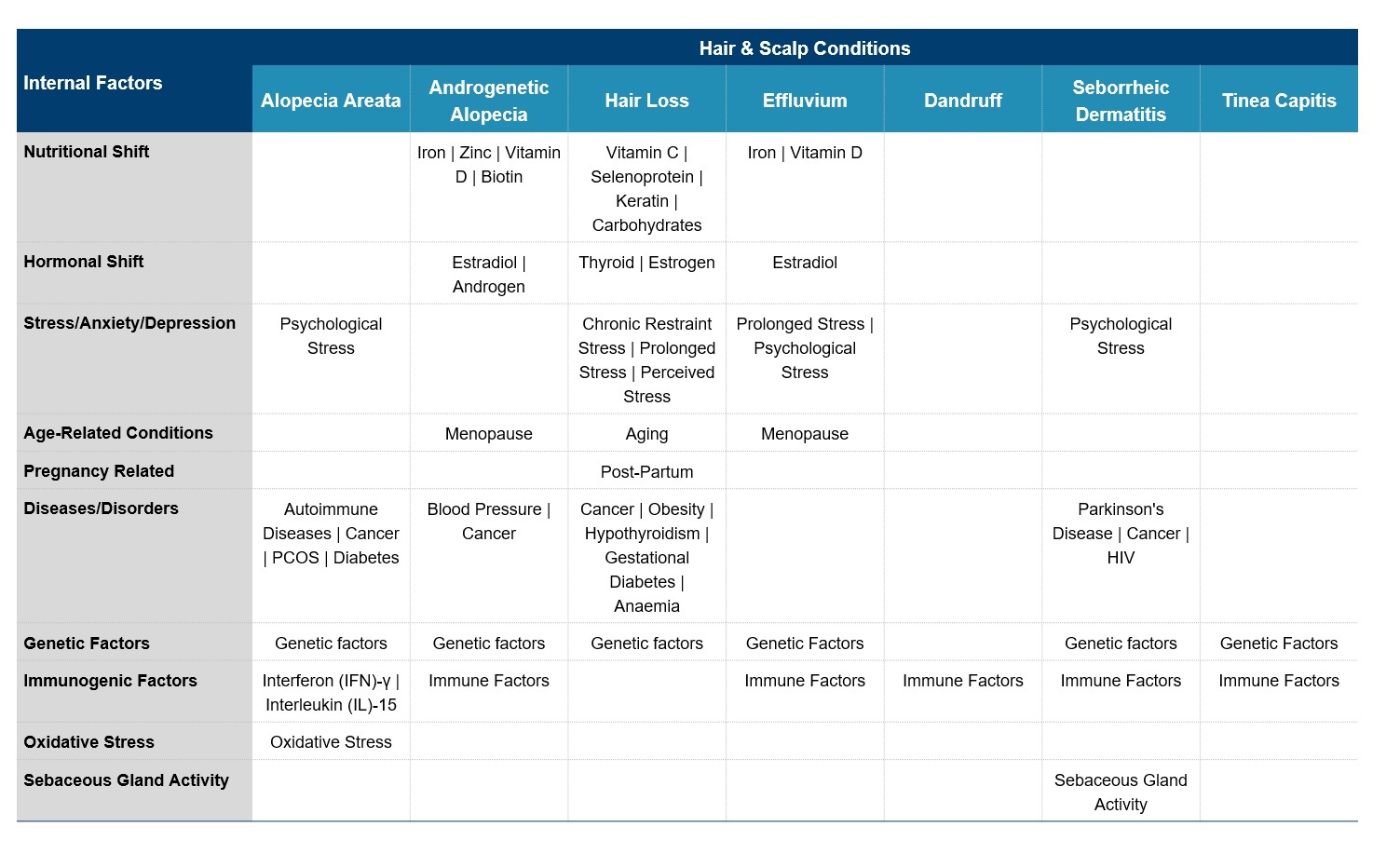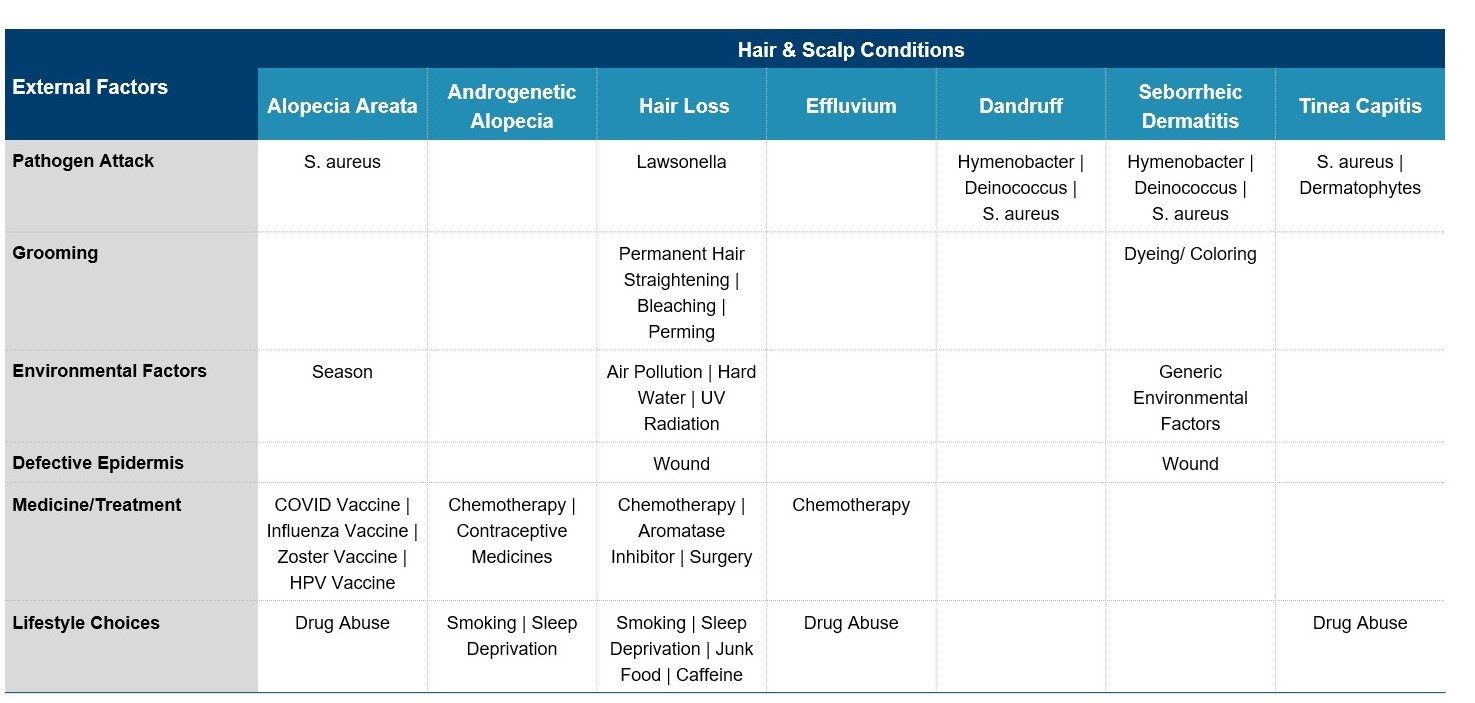Exploring the Complexities of Hair Loss: Insights into Causes and Research Trends
Published on 12 Oct, 2023

Hair loss is a pervasive worldwide concern. It can be caused due to various conditions such as androgenetic alopecia, alopecia areata, and telogen effluvium. The past decade has witnessed extensive research efforts dedicated to understanding the intricate factors that cause hair loss, delving into internal and external elements, alongside the impact of signaling pathways in varying manifestations of hair loss. While some studies have explored genetic predisposition associated with androgenetic alopecia, others have researched the role of hormonal imbalance linked to conditions such as polycystic ovary syndrome (PCOS) and thyroid disorders.
Efforts and Collaborations in Hair Loss Research
Major players in the beauty and hair care industry, including L'Oréal and Procter & Gamble (P&G), are actively researching various factors affecting hair and scalp health to develop new approaches for preventing or mitigating hair loss. L'Oréal, for instance, has pioneered a method to analyze an individual's scalp at the molecular level to detect hair loss before it occurs using gene expression analysis for diagnosis and prediction. Such innovative techniques hold a lot of potential in advancing hair loss treatments.
P&G brand KeepItAnchored has demonstrated that managing oxidative stress in the scalp can enhance hair anchorage and potentially reduce hair loss. This underscores the significance of scalp health and combating free radicals to positively impact overall hair retention and well-being.
Pharmaceutical and cosmetic giants, including Johnson & Johnson, are dedicating substantial resources to R&D focused on hair loss. They are investing in researching active ingredients, conducting clinical trials, advancing product development, and launching marketing initiatives. In addition to industry leaders, startups and smaller companies in the hair care and biotechnology sectors are exploring innovative strategies such as stem cell therapy, personalized treatments, and advanced delivery systems. Regions with strong biotechnology and pharmaceutical sectors – like the US, Western Europe, Japan, and South Korea – are witnessing heavy investments in hair loss research. Renowned institutions including Johns Hopkins in North America and Cambridge in Europe focus on addressing hair loss through research on inflammation, immune responses, and scalp microbiome imbalance. In Asia-Pacific, universities and innovative companies investigate genetic markers, cellular signaling pathways, and personalized hair loss treatments.
Factors and Mechanisms of Hair Loss
Hair fall and scalp issues result from various internal and external factors, including genetics, hormonal changes, aging, stress, poor nutrition, medical conditions, medications, hairstyling practices, and environmental factors. These factors can contribute to conditions like androgenetic alopecia, hair thinning, and patchy hair loss.
Table 1: Internal factors causing different types of hair loss or scalp conditions.

Table 2: External factors causing different types of hair loss or scalp conditions.

Hair loss is influenced by crucial signaling pathways. The androgen receptor signaling pathway involves androgen activation, leading to hair follicle shrinkage and eventual thinning and baldness in androgenetic alopecia. The Wnt/β-catenin pathway is vital for hair follicle development and maintenance, promoting hair growth and regeneration when activated. Conversely, the transforming growth factor-beta pathway can impede hair growth by prematurely inducing the resting phase of hair follicles. Disruptions in the Sonic hedgehog pathway can also contribute to hair loss by affecting hair follicle development. The insulin-like growth factor pathway regulates hair growth and disturbances can impair follicle function. Inflammatory signaling negatively affects hair follicles, with conditions such as alopecia areata causing patchy hair loss due to immune-mediated inflammation. The Notch signaling pathway maintains hair follicle stem cells, influencing follicle regeneration and cycling. Understanding these factors is essential for identifying suitable treatments for hair fall, hair loss, and scalp conditions.
Hair health has suffered from the repercussions of the pandemic. Incidences of telogen effluvium was on the rise, driven by the increased use of medications and elevated stress levels associated with the crisis. Additionally, a potential rare side effect linked to COVID vaccination involves the development of alopecia areata. Vaccines can stimulate immune responses that might adversely affect genetically predisposed individuals, leading to reports of the onset or worsening of alopecia areata after vaccination. The impact of stress is also substantial in this context, as Harvard University researchers have revealed how persistent stress influences hair follicle stem cells. Their discovery highlights that a primary stress hormone extends the dormant phase of these stem cells, impeding the regeneration of hair follicles or hair. Identifying the specific cell type and molecule transmitting stress signals to stem cells suggests a potential path for intervention to restore hair growth.
Future Prospects
The scope of research in hair loss promises avenues for better comprehension, management, and treatment of this widespread issue. Technological advancements in wearable devices and apps could facilitate hair health monitoring, tracking therapy progress, and devising personalized guidance. Additionally, a deeper understanding of how nutrition, stress management, and lifestyle impact hair health could lead to holistic approaches for preventing or mitigating hair loss. Researchers are also exploring the potential of comprehensive formulations that address multiple factors simultaneously, potentially yielding more effective solutions for individuals struggling with hair loss. Such formulations might also reduce the necessity for combining various treatments or medications, resulting in fewer side effects and improved patient adherence. These evolving avenues suggest a more thorough and patient-centric approach to addressing hair loss concerns.

